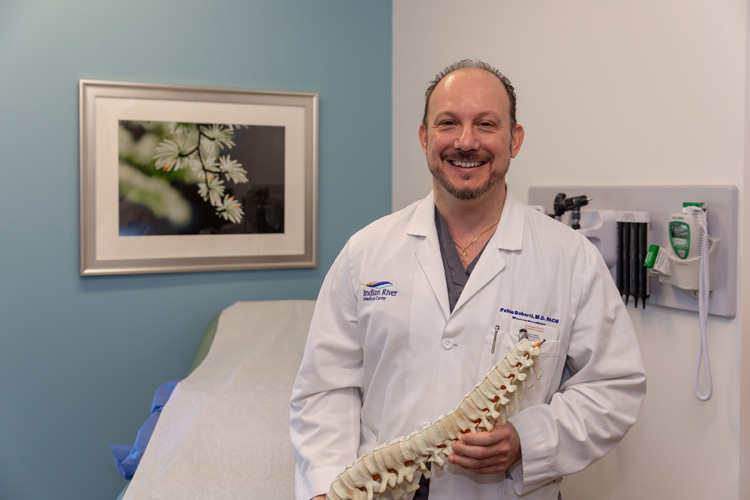
A substantial portion of patient visits to doctors in this country are due to osteoporosis and compression fractures of the vertebrae, according to the National Institutes of Health.
Given this area’s older population, osteoporosis-related spine fractures are especially common here.
These fractures are generally caused either by trauma or by the age-related breakdown of the cartilage of the joints and discs in the neck and lower back. They can lead to chronic pain and spinal deformity.
A procedure known as vertebroplasty has long been a common method of treating spinal compression fractures, but in January the New York Times published a scathing article on the procedure, in which bone cement is injected into the spine in an attempt to “stabilize” one or more of the 33 bones that make up the spinal column.
The Times article was based on an American Society for Bone and Mineral research task force report, and according to the paper, vertebroplasty “relieves pain no better than a placebo.”
Dr. Fabio Roberti, director of neurosurgery at Cleveland Clinic Indian River Hospital, agreed to weigh-in on the questions raised by the report and article. (Why consult a neurosurgeon about back pain? Because the spinal cord begins at the base of the brain where messages from our body’s pain receptors are processed and the spine itself is simply jam-packed with pain receptors.)
“This is an important topic for our community,” says Roberti, “I’m glad you brought it up.”
The ASBMR report, according to Roberti, is a “meta-analysis,” meaning it “chooses all the major studies available” to compare and contrast the effective success rates for multiple forms of treatment and procedures.
“Meta-analysis studies are very good, because they give you an idea of what’s out there,” Roberti says.
Vertebroplasty did not fare well in this particular study. Or in other trials.
In fact, according to the National Institutes of Health, “two double-blind, randomized, placebo-controlled trials of vertebroplasty demonstrated that this procedure was no better than a sham intervention, [meaning without the injection of the cement] in relieving pain or improving function for patients with vertebral fractures.”
Roberti, however, is quick to add that not all vertebral augmentation procedures using bone cement should be colored by the same brush.
“I only use balloon kyphoplasty. Not vertebroplasty,” says this veteran neurosurgeon. “If we actually read into this study, vertebroplasty is not associated with improvement. But other techniques, including kyphoplasty, are associated with improvement” in pain relief, enhanced movement and function.
Kyphoplasty is a newer, modified version of vertebroplasty in which a balloon is inserted into the collapsed vertebrae and inflated to elevate the bone to its proper position and then removed. This, according to NIH, “enables the application of more viscous cement at much lower pressure than is needed in vertebroplasty. This results in less cement leakage and fewer complications.”
Even so, Roberti cautions that any surgical procedure should take a back seat to a more conservative approach. “We need to do medical management first,” he says, because, while some back-pain patients clamor for immediate surgical intervention, the tried and true prescription of rest – possibly with the aid of pain killers, a back brace and mild physical therapy – often resolves these back problems in just a few weeks.
“We do these non-surgical treatments first because surgeries carry complications, time and cost,” Roberti explains. He adds that Medicare will not pick up the cost for any surgical intervention – minimally invasive or otherwise – unless the more conservative approach has been tried first.
Taking a step back from treatment, Roberti says the most important thing “is prevention of vertebral fractures. That’s No. 1. Osteoporosis needs to be prevented, and by preventing osteoporosis we, of course, prevent the onset of these fractures.”
He points to increased intakes of Vitamin D and calcium as good first steps for prevention and adds there are new “stronger medications we can use and should use if patients start having this problem.”
Women in general – and post-menopausal women in particular – are more likely to suffer vertebral fractures than men, although both sexes are susceptible.
“I have data I was reviewing recently, and 20 to 30 percent of females will experience a vertebral fracture in their life,” Roberti says, “compared to 10 percent of males. That’s significant.”
And, “when a patient experiences one vertebral fracture in their life, they have a higher risk of experiencing a second one.” Or a third, or fourth, or more.
Back to treatment, Roberti says there is no one-size-fits-all solution to fractures of the vertebrae. “What’s good for Patient A may not be good for Patient B. We’re all different.”
So the best thing to do is to talk with your primary care physician. He or she may suggest a bone density test or possibly refer you to a specialist for treatment, including surgery, if needed.
Dr. Fabio Roberti is the director of neurosurgery at Cleveland Clinic Indian River Hospital. His office is at 3450 11th Court, Suite 301 in Vero Beach. The phone number is 772-563-4741.
Main image: Dr Fabio Roberti, by Denise Ritchie, Vero Beach 32963



